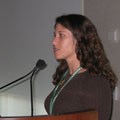
Department of Biology Suffolk University 41 Temple Street Boston, MA 02114 (617) 573-8603 e-mail author
Delivered at 2008 Boston Harbor Islands Science Symposium.
Dr. Nolfo-Clements discussed the preliminary results of 2 projects on the Boston Harbor Islands. 1) A least tern nesting colony on Lovells Island suffered complete decimation during the 2007 breeding season. In an effort to uncover the culprit, motion sensing and infrared detection remote cameras were set in the former nesting area of the least terns. Dummy nests baited with domestic quail eggs were placed at camera trap sites. Both mammalian and avian species were documented in the nesting area. American crows, rats and European rabbits were recorded as nest destroyers/predators. 2) In the first part of a multi–year study aimed at uncovering patterns of small mammal diversity and habitat use on the harbor islands, one-hundred live traps were set on Lovells Island. After over 500 trap nights, only one immature introduced rat (Rattus norvegicus) was documented. Traps were then moved to Bumpkin Island where over 120 individual animals were captured in 800 trap nights. There were over 230 captures (including recaptures) on this island. The island is inhabited by native white–footed mice (Peromyscus leucopus) and meadow voles (Microtus pennsylvanicus). Preliminary observations indicate that population density of small mammals on Bumpkin Island is very high. The predation pressure, however, on these small mammals by coyotes is intense, resulting in the use of traps as safe havens and potential nesting sites. |
Last updated: February 26, 2015
